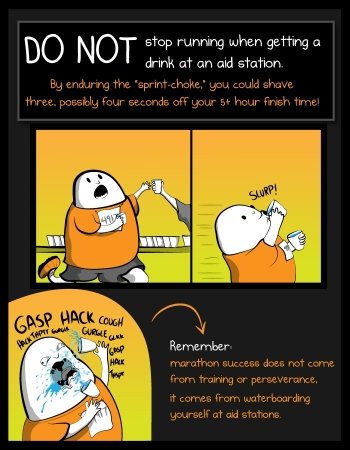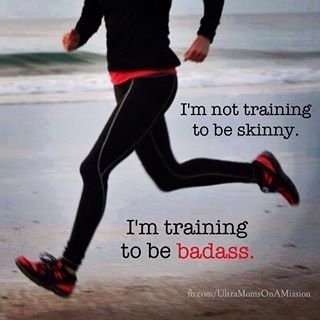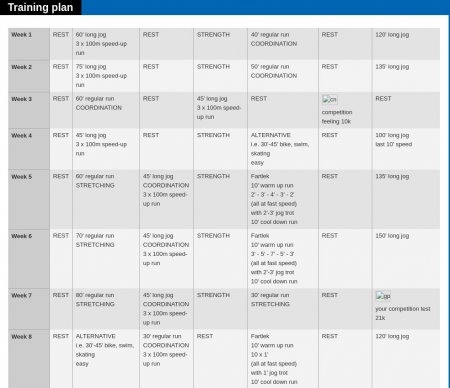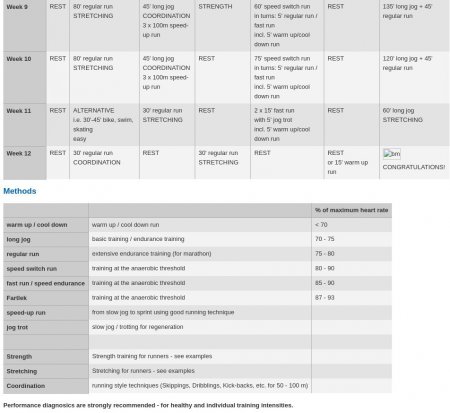Пробежать марафон (надо еще дописать)
Хочу пробежать марафон в следующем году, в крайнем случае - через год. Пока я не знаю точно, как сложится моя жизнь, поэтому не могу поставить точные временные рамки.
Критерий завершения
Достигнуть финиша дистанции, производя конвульсивные движения, отдаленно напоминающие бег
Личные ресурсы
98 евро за регистрацию+6 евро на аренду чипа + optional: medal engraving 9 euro, HD video 5 euro, могучая сила воли и слабая сила мышц
-
Регистрационные моменты
Марафон в Берлине: http://www.bmw-berlin-marathon.com/
Примерные даты для регистрации:
The pre-registration starts on the 18th of October.
You have time to register until the 2nd of November.
Политика отмены: 100% невозвратный взнос.
Полумарафон в Берлине: http://www.berliner-halbmarathon.de/en/
Проходит в конце апреля.
-
WikiHow
Plan for regular medical checkups throughout your training, to ensure that all is well.
It is taboo to take any painkillers within 48 hours of the start and at least 8 hours after the BMW BERLIN MARATHON, as Diclofenac, Iboprofen etc. can limit the functioning of the kidneys during the race, leading up to complete kidney failure or severe cardiovascular problems.
Be aware that running can expose latent injuries from previous sports activities. If you have any such old injuries, discuss this with your doctor.
Ensure that your diet is in top shape.
Obtain a good anatomy book or app. It's really helpful to understand your body's muscles, bone structure and systems through visualizing them as well as learning about how they contribute to your overall well-being.
Of most importance is the gear for your feet, and while some marathon runners have always preferred running barefoot, most people prefer a supportive shoe.Socks: Most marathon runners prefer wearing socks to absorb sweat when running and to prevent chafing against the shoe. There are plenty of choices in the running stores but you may like to experiment with natural and synthetic fibers to see which work best for you. Before any race, check that your gear is well worn in; you don't want to be breaking in new shoes!
Hats: Don't run without a hat; choose one that allows for plenty of air circulation and won't come off in a gust of wind. A visor is probably best for hot weather runs, as it lets the heat out easily.
Clothing: For women, get a good, supportive sports bra.
Про одежду: most runners advise "ABC" or "anything but cotton" because cotton adds weight by holding in sweat.
Eyewear: It's recommended that you wear runner's sunglasses to protect your eyes from UV rays. Runner's sunglasses have such features as special grips, ventilation holes, side glare cutters, shatterproof when dropped, lightweight, etc.
Accessories: Some of the helpful items that you might like to have include a runner's belt to hold food, supplements and water; a water bottle; a night light for training when it's dark; and sun protection (sunscreen). Some runners also like to have their own running watch to pace themselves during a race.
Concentrate on your breathing. Inhale deeply from your diaphragm (pit of your stomach) to ensure deep, even breathing that maximizes your breathing. Shallower breathing is what tends to lead to runner's stitch.
Choose an area that is safe, enjoyable and has plenty to look at so that you find the experience interesting enough to want to repeat it!
Whenever you start a run, give yourself 10 minutes before giving up––often it is these first 10 minutes that give you the energy and mindset to keep going.
It can be very helpful to maintain a running diary, either in paper or digital form.
If you include stretching as part of your running (not everyone agrees that it's essential or helpful), be sure to stretch correctly.
Consider joining a running group or club. Even if you don't plan on training with the club regularly, it's a good way to get reputable information and advice and there will undoubtedly be events that you'll be interested in entering to test your progress.
Run a half-marathon. Concentrate on building up your endurance with strength runs, semi-long runs, a longer run and rests. Including one day of rest each week of training is important for recovery.
When training, include a variety of running experiences, including uphill and downhill, sand running, fartlek, interval training and speed endurance sessions. Moreover, don't just train by running––some cross-training will benefit your overall fitness level, as well as giving your running muscles a deserved break. Suitable cross-training sports include swimming, cycling, gym workouts, walking and fitness dance.
Register for the marathon.
Give yourself around 18 weeks before a marathon to train to an adequate level.
Focus intently on establishing a healthy marathon pace. It's very important to understand that this pace differs from what most people perceive as a "normal" pace and you'll need to adapt to it, usually by slowing down somewhat.
Training should gradually (not suddenly) taper in the final two weeks to protect your body from injury and exhaustion. By the final week, you should be in a position to not run at all in the two days leading up to the race.
Check out the course in advance. Where possible, drive or cycle the marathon course before it happens. That way, you'll know what it's like generally and this will instill in you the importance of pacing yourself well because it is such a long race! Take especial note of particular landmarks and note their distance on your car or bike computer readout.
Watch movies about running a marathon.
Typical food eaten by marathon runners includes bread (wholegrain), pasta, cereals and the like. These provide the glycogen that breaks down into glucose for energy as you're running and when your body has broken down your stored glycogen, it then goes after your liver glycogen, after which it goes for your fat which requires more of your precious oxygen to break down the molecules into glucose. Hence, the more stores of glycogen you have, the better.
Run the marathon.
- Line up where you feel comfortable and likely to be among runners of the same level as you––as with the half marathon, avoid pushing your way to the front as a beginner.
- Hydration also replaces water lost to sweating as your body tries to keep cool and you need to replenish a minimum of 0.5 of a liter of water (17 oz) per every hour.
- You might "hit a wall"––this occurs for many marathon runners at around the 32 km (20 mile) mark of the marathon, a feeling that you're running through thick mud and literally hitting a brick wall.[1] It tends to be caused by poor training in the lead up to the marathon and by running at a pace too fast at the commencement of the race, leaving little in reserve for later. To avoid the brick wall experience, know your pace and stick to it from the beginning, avoid the temptation to try to keep up with other runners, eat extra carbohydrates in the lead-up to the race and stay well hydrated during the marathon.
Plan for after the marathon. Have someone help you after the race––you'll need warmth, drinks and food. And you'll need a lift home with someone who hasn't just run a marathon.
-
Tips WikiHow
- It's important to get proper nutrition during the marathon. This can come from sports drinks, gels, bananas or jelly beans. Sports drinks and gels often contain electrolytes which you should ensure you replace, especially during the first half of the race. Your body isn't designed to store more than 20 miles (32 kilometers) worth of calories, so you need to get some during the race (this is another reason why many runners "hit the wall"). However, it is important that you do not mix sports drinks AND gels at once, unless you have tried this during training runs. The combination of the two can lead to GI distress and ruin your race.
- If you're training like a marathoner, you should eat like one too. Carbs, protein, calcium, iron, and other vitamins are all essential for you to train like you need to. Cut out as much junk food as possible (and preferably all of it).
- Be prepared for your body to do some strange things as it responds to the significant distance. Toenails will turn black, and other parts will chafe. Deal with these problems early on, and they won't be a concern on race day.
- While running your race, if you begin cramping, there is a good chance you are low on sodium. This can happen from excessive sweating, lack of electrolytes (either by over hydrating through water or insufficient intake of sports drinks during your physical exertion). A very quick and easy fix is to ingest salt- either through a tablet, a salty food such as pretzels or as a last resort, simply drinking sports drinks. It is not a bad idea to carry a small salt pack (the kind you would get at a fast food store) to eat should cramps appear during your race. The effect is almost instantaneous to resolve muscle cramps.
- Get to the race early, and get in a porta-potty line right away. When you're done, get right back in line. This helps to keep you from having to stop once the race has already started. Some runners pin sheets of toilet paper to the inside of their clothing, just in case––the excitement of running does tend to give you the "runs"!
- Do NOT try anything new on marathon day. Anything you think you may want to do during the race, you should try during your long runs.
- After the race, take an Epsom salt bath. It helps pull out lactic acids and can help with soreness and stiffness as well as inflammation. Add the salts to a warm bath and soak for 20 minutes. It is relaxing and will significantly help ease the effects of running for 26.2 miles (42 km).
- Invest in a good pair of shoes (or two). A good pair of running shoes should cost you $50-$120 and will last about 300-500 miles (500-800 km). Go to a running specialty store and get fitted for shoes by an expert, if you can, before you start your training. Ideally, you can buy two pairs of shoes and rotate them every other day.
- Imagine yourself running nice and calmly yes, but you also can imagine yourself dealing with the more stressful elements of a race as well. And then imagine being able to overcome them – being drawn by the crowds at those key moments, or focusing on your breathing, or setting yourself small goals. Practise overcoming the moments that won’t naturally be on your internal movie.
- People tend to look down at the ground when they are running. That’s unhelpful in various ways – one is that we tend to internalise when we look down. We tend to talk to ourselves more, and feel more pain when we look down. Look up, and instead of staring at things, try to use your peripheral vision. When you use your peripheral vision you go into a kind of light trance, the zone state. So you feel less – well, I like to say discomfort rather than pain! If you are using your peripheral vision, it’s also much much harder to feel stress. You actually have to look for it. When we are stressed or feeling pain we tend to have a narrower focus – tunnel vision – so we zoom in on that pain.
- If the marathon is your end goal it can be a problem – whether it’s a good or bad day. What happens afterwards? You get this at top level too – people who want to win the gold medal or a particular tournament because it has been their life’s dream. They achieve it – and then quite often people don’t achieve very much after that, because they haven’t set anything up for afterwards. So set a goal for afterwards, even if it’s just a small fun run. Then your marathon becomes a stepping stone in itself and you have something to move on afterwards can really help the mind focus. And it means all that training you’ve done isn’t just for one thing. That gives meaning to your run whether it goes well or not.
http://www.active.com/running/articles/how-to-run-your-first-marathon прочитать
![]()
-
Warnings WikiHow
This can happen:
- Chafing - this can result from clothing rubbing on your skin or skin rubbing on skin and can be quite unpleasant. Remove clothing labels where possible.
- Blisters - these are fairly commonplace for runners and have their own level of pain. Be careful if they burst from rubbing, as infection can occur. Some ways to prevent blisters include: wear correctly-fitting shoes, keep toenails trimmed to fit the shoes properly, wear socks that wick away moisture and don't bunch up.
-
alexNotes
-
Кроссы
-
Приложение годное
-
Уши или EarPods last generation
-
Runnig & crossfit clothers
-
абонимент тренажерки
-
-
Books
- ↑ 1.01.11.21.31.41.51.61.71.8Bruce Fordyce, Marathon Runner's Handbook, (2002), ISBN 1-85974-723-X не нашла для скачивания, но скачала аналогичные книги.
- ↑ 2.02.1Harold Tinsey, Training for the Marathon, www.runrocketcity.com/training.pdf, retrieved 18th July 2012 скачала
- ↑ 3.03.1Brian Rohrig, The Chemistry of Marathon Running, ChemMatters, October 2008 скачала
-
Accessories
![]()
-
Тренировочные программы
http://www.runnersworld.com/tag/marathon-training... только платно 10 долларов за план для First-Time-Marathon
http://www.marathonrookie.com/
http://www.marathon-training-program.com/stretching/
С сайта http://www.coolrunning.com/engine/2/2_4/130.shtml:
Beginner Marathon Program
A training schedule for beginning runners who want to start racing the marathon distance.Posted Monday, 8 September, 1997
First things first: bookmark this page so that you can check on your progress. You can also add daily run reminders to the Cool Running homepage as you roll through the weeks of this training program (to do this, edit your start page preferences).
Unlike many other marathon programs, your long runs here build up to include the actual marathon distance. This is based on the common-sense idea that to be prepared to race any distance, you should train at that distance.
For runners (particularly first-time marathoners) who are more interested in simply finishing the marathon than in racing or running for time, it's not necessary to run the complete marathon distance during training. If this is you, we recommend making the following adjustments to the long Sunday runs:
- Week 5, Sunday: 10 miles
- Week 7, Sunday: 12 miles
- Week 9, Sunday: 14 miles
- Week 11, Sunday: 16 miles
- Week 13, Sunday: 18 miles
- Week 15, Sunday: 20 miles
- Week 17, Sunday: 20 miles
Whether you're running for time or just running to finish, the key either way is to train gently. All of your long runs should be run at a pace about 90 seconds or 2 minutes per mile slower than your current 10K pace.
This program contains some speed workouts. (For more information on the types of speed workouts, we lay it all out in "The Runner's Building Blocks"). A few quick notes on how speedwork is described here:
- The distance in parentheses below fartlek runs includes a mile each of warmup and warmdown, in addition to your fartlek sessions. Don't know what a fartlek is? Check out our page about "The Runner's Building Blocks".
- Whenever you see a pace denoted as 5K pace or 10K pace, this refers to the speed at which you estimate you could run a 5K or 10K on that given day.
- When you read "4-5 hills," that means you should do 4-5 repeats at 5K pace on a hill about 150 or 200 yards long. Long hills should be 400-600 yards long. If you find it too tedious to run repeats on a single hill, you can also find a route that incorporates the same number of hills, as long as the route is not very long.
- When you read the notation "4 x 880s," that means you should run four repeats of 880 yards each (two laps on the track). The pace below tells you how fast you should run them. For 880s, give yourself 2 minutes of rest between intervals; for 440s, give yourself 1-2 minutes.
All other workouts (including the long runs) should be run at an easy training pace -- emphasis on "easy." Hold yourself back to a pace about 90 seconds or 2 minutes per mile slower than your current 10K pace.
Finally, the pre-training schedule. You should be able to run this schedule for four to five weeks without much discomfort before starting the marathon program. If not, give yourself some time to build up to that level gradually, or you may risk injury.
Mon.Tue.Wed.Thu.Fri.Sat.Sun.Pre-
TrainOff3M4M4MOff3M6M
The scheduleThe schedule peaks at about 45 miles per week. If you prefer metric distances, use our distance-conversion calculator to convert to kilometers.
WeekMon.Tue.Wed.Thu.Fri.Sat.Sun.1Off3M4M4MOff3M6M2Off3M5M3MOff3M7M3OffFartlek
(4M)5M3MOff3M8M4OffFartlek
(4M)3M4MOff3M10M5Off4-5 Hills
5K-10K pace3M4MOff3M12M6Off3-4 Long Hills
5K-10K pace4M6MOff5M5M7Off3 x Mile
5K-10K pace3M5MOff3M15M8Off6M5M6MOff5M7M9Off5-6 Hills
5K-10K pace4M7MOff3M18M10Off7M6M7MOff6M9M11Off4-5 Long Hills
5K-10K pace5M8MOff3M20M12Off3 x Mile
5K-10K pace5M8MOff3M10K Race
(Or 10M)13Off6 x 880s
5K-10K pace6M8MOff3M22M14Off7M5M8MOff5M10K Race
(Or 10M)15Off6 x 880s
5K-10K pace6M8MOff3M24M16Off4 x Mile
5K-10K pace7M10MOff4M10K Race
(Or 10M)17Off5M3M5MOff3M26M18Off6M5M8MOff4M12M19Off5M4M6MOff3M12M20OffFartlek
(5M)4MOffOff2MRACE DAY!![]()
![]()
![]()
-
Просмотреть
- 2334
- 30 августа 2015, 15:02
Не пропустите новые записи!
Подпишитесь на цель и следите за ее достижением








